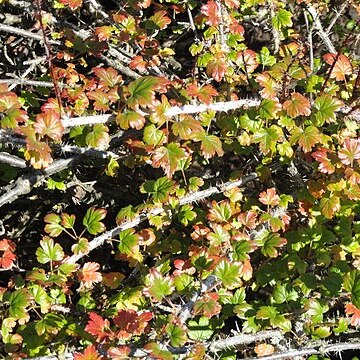Shrubs to 1 m tall or slightly more. Branchlets glabrous; nodal spines 3-7, verticillate, needlelike, to 1 cm; internodes spiny. Buds oblong, 4-6 mm, apex acute; scales scarious. Petiole to 3 cm, glabrous to sparsely puberulent; leaf blade broadly ovate to suborbicular, 1.5-3 × 3-5 cm, mostly glabrous, abaxial vein-axils sparsely puberulent, base truncate to cordate; lobes 3-5, margin coarsely acutely serrate, apex obtuse or acute; terminal lobe subequaling lateral ones. Flowers solitary or 2 or 3 in short racemes, bisexual; rachis 1-1.2 cm; bracts ovate to narrowly so, 2-3.5 mm, 3-veined, usually glabrous; pedicel 3-6 mm, glabrous or sparsely stalked glandular. Calyx greenish white tinged yellow or pink; tube broadly campanulate, 4-6 mm, glabrous on both surfaces; lobes reflexed, spreading or erect in fruit, oblong to spatulate, 5-6 mm. Petals white, obovate, 2-3.5 mm. Stamens slightly longer than petals; filaments white; anthers ovoid-ellipsoid. Ovary glabrous, rarely sparsely stalked glandular. Style glabrous, divided for ca. 1/2 its length. Fruit red, globose, 1.2-1.5 cm, glabrous or sparsely stalked glandular. Fl. May-Jun, fr. Jul-Aug.
More
A shrub. It grows 1 m tall. The stems have sharp bristles. The bark is light grey. The leaves are rounded and have 3-5 lobes. Leaves are up to 3 cm wide. They are shiny above. The flowers do not have stalks and are greenish-white or pink. The fruit are berries 1-1.5 cm wide. The fruit are red, green or yellow.
It is a cold temperate plant. In Kazakhstan it grows on stony slopes in low mountain belts. In western China it grows between 1,500-2,100 m above sea level.
More
Open stony mountain and hill slopes. Forest margins, thickets and rocky slopes; at elevations from 1,500-2,100 metres in northern China.

